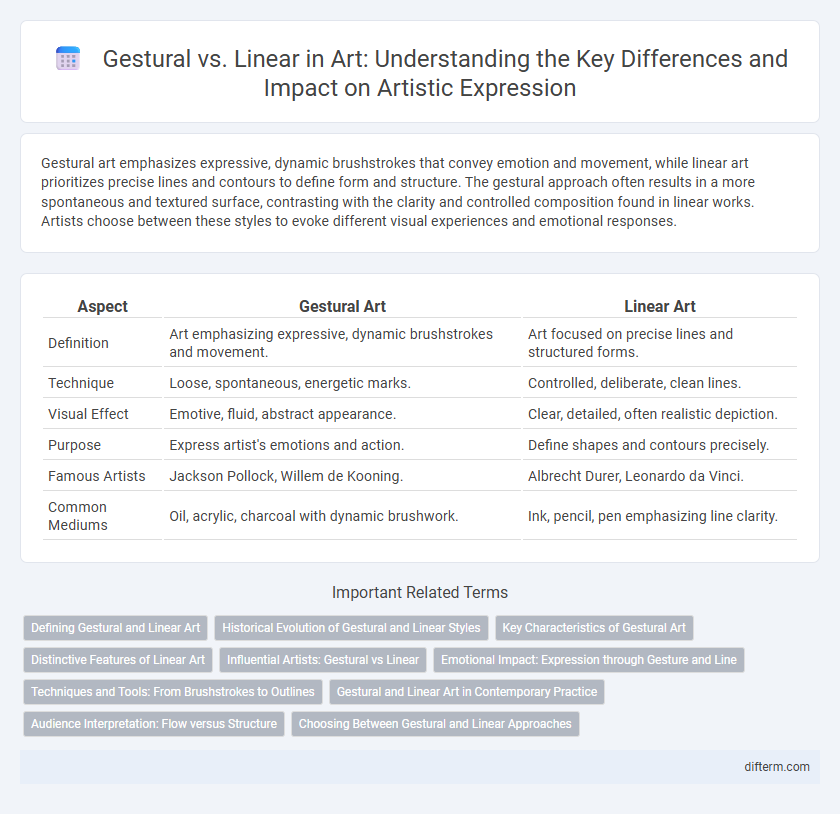Gestural art emphasizes expressive, dynamic brushstrokes that convey emotion and movement, while linear art prioritizes precise lines and contours to define form and structure. The gestural approach often results in a more spontaneous and textured surface, contrasting with the clarity and controlled composition found in linear works. Artists choose between these styles to evoke different visual experiences and emotional responses.
Table of Comparison
| Aspect | Gestural Art | Linear Art |
|---|---|---|
| Definition | Art emphasizing expressive, dynamic brushstrokes and movement. | Art focused on precise lines and structured forms. |
| Technique | Loose, spontaneous, energetic marks. | Controlled, deliberate, clean lines. |
| Visual Effect | Emotive, fluid, abstract appearance. | Clear, detailed, often realistic depiction. |
| Purpose | Express artist's emotions and action. | Define shapes and contours precisely. |
| Famous Artists | Jackson Pollock, Willem de Kooning. | Albrecht Durer, Leonardo da Vinci. |
| Common Mediums | Oil, acrylic, charcoal with dynamic brushwork. | Ink, pencil, pen emphasizing line clarity. |
Defining Gestural and Linear Art
Gestural art emphasizes dynamic brushstrokes, spontaneous movements, and expressive marks that convey emotion and energy, often highlighting the artist's physical interaction with the medium. Linear art prioritizes precise lines, contours, and structured forms to create clear shapes and detailed representations, focusing on clarity and control. Both styles reflect distinct approaches to expressing visual narratives through either fluid motion or defined outlines.
Historical Evolution of Gestural and Linear Styles
Gestural and linear styles in art have evolved significantly since the early 20th century, with gestural techniques emerging from Abstract Expressionism as a means to convey emotion through dynamic brushstrokes and spontaneous movement. Linear style, rooted in classical traditions and Renaissance art, prioritizes precise contour lines and structured forms to create clarity and definition. Over time, artists like Jackson Pollock advanced gestural abstraction, while others preserved linear methods, reflecting shifts in artistic intentions and cultural contexts.
Key Characteristics of Gestural Art
Gestural art emphasizes dynamic, expressive brushstrokes that convey emotion and spontaneity, often resulting in a textured, vigorous surface. This style prioritizes movement and the physical act of painting, contrasting with the precise, controlled lines characteristic of linear art. Key characteristics include loose, sweeping marks, visible brushwork, and an organic, energetic composition that captures the artist's immediate gesture.
Distinctive Features of Linear Art
Linear art emphasizes precise, clean lines and defined edges, creating a clear structure and form that guides the viewer's eye. This style prioritizes contour and outline over texture and color, often resulting in a minimalist or graphic appearance. Artists like Albrecht Durer and Aubrey Beardsley exemplify linear art through their detailed line work and emphasis on drawing techniques.
Influential Artists: Gestural vs Linear
Influential artists in the gestural art movement, such as Jackson Pollock and Willem de Kooning, emphasized dynamic brushstrokes and emotional intensity to convey raw energy. In contrast, linear artists like Piet Mondrian and Albers focused on precise, geometric lines and structured composition, highlighting order and clarity in their work. These contrasting approaches have significantly shaped the evolution of modern and contemporary art by exploring the relationship between spontaneity and control.
Emotional Impact: Expression through Gesture and Line
Gestural art harnesses dynamic, sweeping strokes that convey raw emotion and spontaneity, intensifying the viewer's emotional engagement. Linear art relies on precise, controlled lines to create structure and clarity, evoking a sense of order and calm. The contrast between gestural and linear techniques illustrates how different artistic approaches can manipulate emotional response through the manipulation of gesture and line.
Techniques and Tools: From Brushstrokes to Outlines
Gestural techniques emphasize expressive, dynamic brushstrokes that capture movement and emotion, often using tools like wide brushes, palette knives, and fingers to create spontaneous marks. Linear approaches prioritize precise outlines and contours, relying on fine-tipped brushes, pens, or pencils to define shapes with clarity and control. Artists may combine both methods to balance fluidity with structure, enhancing visual narrative through varied textures and line quality.
Gestural and Linear Art in Contemporary Practice
Gestural art emphasizes expressive, dynamic brushstrokes that capture the artist's movement and emotion, often resulting in abstract or spontaneous compositions. Linear art prioritizes precise, clean lines and structured forms, creating clarity and definition within the artwork. Contemporary practice frequently explores the tension between gestural spontaneity and linear control, blending these approaches to challenge traditional boundaries and convey complex narratives.
Audience Interpretation: Flow versus Structure
Gestural art emphasizes dynamic brushstrokes and expressive movement, inviting the audience to experience emotion and spontaneity through fluid visual flow. Linear art prioritizes precise lines and defined shapes, guiding viewers toward a structured and analytical interpretation of form. Audience interpretation shifts from feeling the energy and rhythm in gestural works to appreciating clarity and order in linear compositions.
Choosing Between Gestural and Linear Approaches
Choosing between gestural and linear approaches in art depends on the desired expression and technique precision. Gestural techniques emphasize dynamic, spontaneous brushstrokes that convey emotion and movement, ideal for abstract or expressive works. Linear methods prioritize controlled, precise lines that define form and structure, making them suitable for detailed, representational art.
gestural vs linear Infographic

 difterm.com
difterm.com